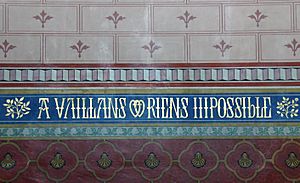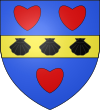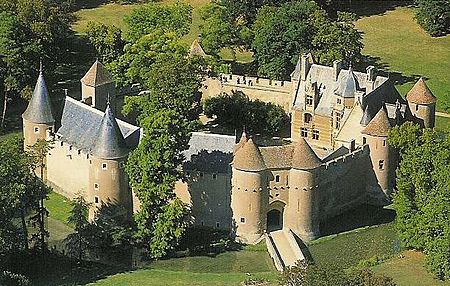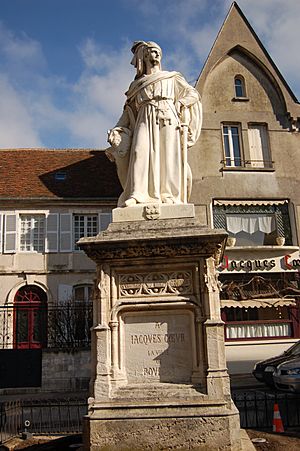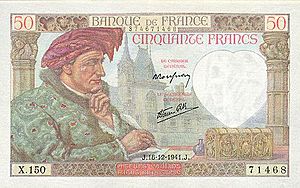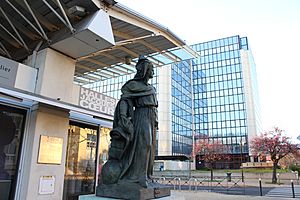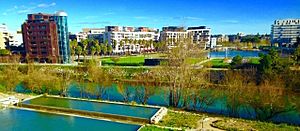Jacques Cœur facts for kids
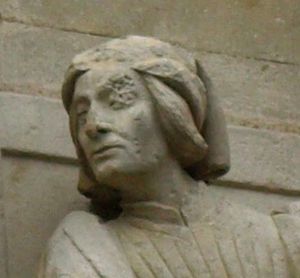
Jacques Cœur (born around 1395 in Bourges – died November 25, 1456 in Chios) was a very successful French businessman and government official. He became incredibly wealthy, which eventually led to his downfall. He was famous for setting up regular trade routes between France and the Levant (the eastern Mediterranean region). Even today, he is a well-known figure in Bourges, where his grand palace still stands.
Contents
Jacques Cœur's Early Life and Family

Jacques Cœur was born in Bourges, a city where his father, Pierre Cœur, was also a rich merchant. We first hear about Jacques around 1418 when he married Macée de Léodepart. Her father, Lambert de Léodepart, was an important citizen and a former assistant to John, Duke of Berry.
Around 1429, Jacques started a business with two brothers named Godard. By 1432, he was in Damascus, buying and trading goods. He brought items like gall-nuts, wools, silks, mohair, brocades, and carpets back to France through Narbonne. In the same year, he set up his main business in Montpellier. Here, he began the huge trading operations that made him famous.
Within a few years, Jacques Cœur helped France compete with the powerful trading cities of Italy. He became so well-known that he even helped the knights of Rhodes and the city of Venice with their trade.
How Jacques Cœur Became Famous
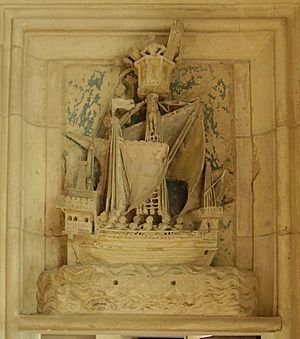
In 1436, King Charles VII called Jacques Cœur to Paris and made him the master of the royal mint. This was a very important job. At the time, France had many different kinds of money from previous reigns, and the King wanted to fix this. Jacques Cœur helped the King greatly with these money reforms between 1435 and 1451.
In 1438, he became the steward of the royal spending. By 1441, he and his family were given noble status by the King. He chose a motto: A vaillans cuers riens impossible, which means "To a valiant heart, nothing is impossible."
Jacques Cœur also took on diplomatic roles. In 1444, he helped lead the new parliament in Languedoc, a position he held for many years. In 1445, his agents helped make a peace treaty between the Sultan of Egypt and the knights of Rhodes. In 1447, his nephew, Jean de Village, went on a mission to Egypt. These efforts greatly improved France's trade and influence in the East.
In 1447, Cœur also helped with a diplomatic visit to Amadeus VIII, who had been chosen as Pope Felix V. In 1448, he represented the French King at the court of Pope Nicholas V. He helped arrange an agreement between Nicholas and Amadeus, which ended a disagreement within the church. Pope Nicholas V treated him with great respect and even allowed him to trade with non-Christians.
Around this time, Jacques Cœur started lending money to King Charles VII to help fund his wars. In 1449, after fighting alongside the King, he rode into Rouen with Charles in a victory parade.
At this point, Jacques Cœur was at the peak of his success. He had represented France in three important diplomatic missions. He had also provided money for the King's successful effort to take back Normandy. He held many important government jobs and had a fortune that people at the time thought was enormous and unheard of.
He employed 300 managers and had businesses in many major French cities. He built houses and chapels, and he founded colleges in Paris, Montpellier, and Bourges. The Palais Jacques-Cœur in Bourges was especially grand. It is still one of the most beautiful medieval buildings in France today. He also built a special room and a family burial chapel in Bourges Cathedral.
His family also became very successful. His brother, Nicolas Cœur, became the Bishop of Luçon. His sister married Jean Bochetel, the King's secretary. His daughter married the son of the Viscount of Bourges. And his son, Jean Cœur, became the Archbishop of Bourges.
Jacques Cœur also bought many properties and titles during his successful years. For example, he acquired the lordship of Ainay-le-Vieil in 1435 and the Château de Boisy in 1447. He also bought the Château de Menetou-Salon and the lordship of Barlieu in 1448, and the lordship of Puisaye in 1450.
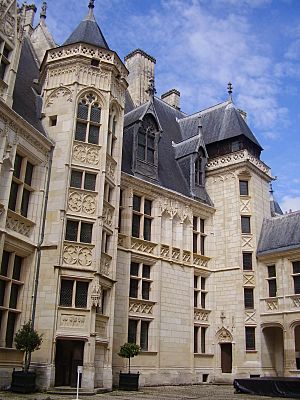
Jacques Cœur's Downfall
Jacques Cœur's huge success and control over trade eventually led to his ruin. He traded in almost everything: money, weapons, furs, jewels, fabrics, and wool. He also worked as a broker, banker, and farmer. He controlled so much of the country's trade that other merchants complained they couldn't make a profit because of him.
He had lent money to many people, including needy courtiers, members of the royal family, and even the King himself. These people, who were jealous of his wealth, were looking for a chance to bring him down.
In February 1450, Agnès Sorel, the King's mistress, died suddenly. About a year and a half later, rumors spread that she had been poisoned. A lady of the court who owed money to Jacques Cœur, Jeanne de Vendôme, and an Italian man, Jacques Colonna, officially accused him of poisoning her. There was no real proof for this charge.
However, because of this and other accusations, King Charles VII ordered Jacques Cœur's arrest on July 31, 1451. The King also seized all of Cœur's belongings, keeping a large sum of money for a war. Special judges were chosen for the trial, and many of them were Cœur's enemies or people who owed him money.
He was accused of sending French gold to Muslims, making fake money, kidnapping sailors for his ships, and committing fraud in Languedoc against the King. Jacques Cœur defended himself strongly. Even though his innocence seemed clear, he was found guilty. After being held in five different prisons for 22 months, he was sentenced. He had to publicly apologize, pay the King a huge sum of money (equal to about £1,000,000 in 1911), and remain in prison until the payment was made. All his property was taken away, and he was exiled from France.
On June 5, 1453, the sentence was carried out. He performed the public apology in Poitiers. For almost three years after this, we don't know much about him, but he likely remained in prison. Meanwhile, his vast wealth was divided among King Charles VII's favorite courtiers.
Escape, Papal Help, and Death
In 1455, Jacques Cœur managed to escape to Provence. He was chased, but a group led by Jean de Village and two of his old managers helped him get away to Tarascon. From there, he traveled through Marseille, Nice, and Pisa, finally reaching Rome.
He was welcomed with honor by Pope Nicholas V, who was preparing a military expedition against the Turks. When Nicholas died, Pope Calixtus III continued his work. He made Jacques Cœur the captain of a fleet of sixteen ships sent to help Rhodes. Jacques Cœur set out on this journey but became ill in Chios and died there on November 25, 1456. After his death, King Charles VII was kinder to Cœur's family and allowed his sons to inherit what was left of their father's fortune.
What Happened Next
After Jacques Cœur's downfall and death, his family tried to get back some of his properties through legal battles. They had some success when Antoine de Chabannes, who had taken over Cœur's lands, lost royal favor for a short time. However, Chabannes soon got all the properties back. The legal disputes between the Cœur family and Antoine de Chabannes's son finally ended in 1489.
Jacques Cœur's Legacy
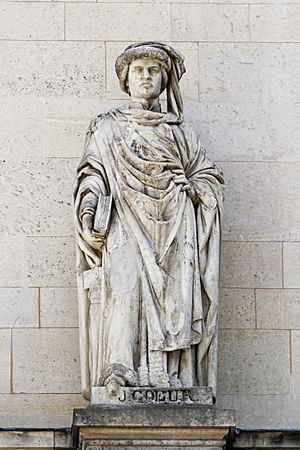
The grand palace Jacques Cœur built for himself in Bourges, known as the Palais Jacques-Cœur, is a major example of French architecture from the 15th century. It was used as a courthouse in the 1800s and carefully restored in the 1900s.
Other buildings are sometimes linked to Jacques Cœur, but not always accurately. The maison de Jacques Cœur in Paris is thought to have been built or bought by his son, Geoffrey. Other old houses in Pézenas, Sancerre, and L'Arbresle are also called maison de Jacques Cœur.
During the Second French Empire (a period in French history), Jacques Cœur was seen as an early example of economic growth. He was honored with a statue by Élias Robert in the Louvre Museum. Another public statue of Jacques Cœur, by sculptor Auguste Préault, was put up in 1879 in Bourges in front of his palace.
He was even featured on a French banknote, the 50 franc note, which was used from the 1940s until 1945.
Many streets and squares in French towns and cities are named after Jacques Cœur, including in Bourges, Montpellier, and Paris. Bourges has honored him in many ways, such as the Lycée Jacques-Cœur (Cœur High School) and the Théâtre Jacques Cœur (Cœur Theater). In Montpellier, Jacques Cœur is linked to the development of the local port of Lattes. Several projects in the late 20th and early 21st centuries were named after him as the city grew towards the sea. These include a marketplace, an artificial lake called the Bassin Jacques Cœur, and a theater.
The Route Jacques Coeur is a scenic road that connects several castles and sights near Bourges. However, many of these places don't have a direct historical connection to Jacques Cœur himself.
How Historians View Jacques Cœur
In a 1997 book, French historian Jacques Heers offered a different view of Jacques Cœur. He suggested that Cœur's success wasn't mainly due to his skills as a merchant. Heers noted that there's no clear proof that Cœur's businesses, like mining near Lyon, made a lot of money. Also, his fleet of trading ships was small (never more than four galleys) compared to those of big Italian or Catalan merchants.
Instead, Heers believed that Cœur's success came mostly from his important position at the royal court. He suggested that Cœur's wealth came from using his special access to government resources. So, Heers saw Cœur less as a brilliant merchant and more as a clever government official who knew how to use his connections.
 In Spanish: Jacques Cœur para niños
In Spanish: Jacques Cœur para niños


